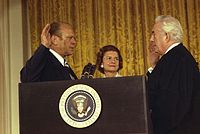
Back تسلسل التداول الرئاسي في الولايات المتحدة Arabic Наследаванне прэзідэнцкіх паўнамоцтваў у ЗША Byelorussian Поредност на заместниците на президента на САЩ Bulgarian Nástupnictví na úřad prezidenta Spojených států amerických Czech Nachfolge des Präsidenten der Vereinigten Staaten German Línea de sucesión presidencial de los Estados Unidos Spanish Ameerika Ühendriikide presidendijärjekord Estonian صف جانشینی ریاستجمهوری ایالات متحده آمریکا Persian Ordre de succession présidentielle des États-Unis French סדר הירושה של נשיא ארצות הברית HE


| Part of a series on Orders of succession |
| Presidencies |
|---|
The United States presidential line of succession is the order in which the vice president of the United States and other officers of the United States federal government assume the powers and duties of the U.S. presidency (or the office itself, in the instance of succession by the vice president) upon an elected president's death, resignation, removal from office, or incapacity.
The order of succession specifies that the office passes to the vice president; if the vice presidency is simultaneously vacant, the powers and duties of the presidency pass to the speaker of the House of Representatives, president pro tempore of the Senate, and then Cabinet secretaries, depending on eligibility.
Presidential succession is referred to multiple times in the U.S. Constitution: Article II, Section 1, Clause 6, the 12th Amendment, 20th Amendment, and 25th Amendment. The vice president is designated as first in the presidential line of succession by the Article II succession clause, which also authorizes Congress to provide for a line of succession beyond the vice president. It has done so on three occasions. The Presidential Succession Act was adopted in 1947, and last revised in 2006. The 25th Amendment, adopted in 1967, also establishes procedures for filling an intra-term vacancy in the office of the vice president.
The Presidential Succession Act refers specifically to officers beyond the vice president acting as president rather than becoming president when filling a vacancy. The Cabinet has 15 members, of which the secretary of state is highest and fourth in line (after the Senate president pro tem); the other Cabinet secretaries follow in the order of when their departments (or the department of which their department is the successor) were created. Those heads of department who are constitutionally not "eligible to the Office of President" are disqualified from assuming the powers and duties of the president through succession and skipped to the next in line. Since 1789, the vice president has succeeded to the presidency intra-term on nine occasions: eight times due to the incumbent's death, and once due to resignation. No one lower in the line of succession has ever been called upon to act as president.
Widely considered a settled issue during the late 20th century, the terrorist attacks of September 11, 2001 demonstrated the potential for a decapitation strike that would kill or incapacitate multiple individuals in the presidential line of succession in addition to many members of Congress and the federal judiciary. In the years immediately following the attacks, numerous wide-ranging discussions were started, in Congress, among academics and within the public policy community about continuity of government concerns including the existing constitutional and statutory provisions governing presidential succession. These discussions remain ongoing. One effort put forward by the Continuity of Government Commission, a nonpartisan think tank, produced three reports (2003, 2009, and 2011), the second of which focused on the implicit ambiguities and limitations in the succession act, and contained recommendations for amending the laws for succession to the presidency.
© MMXXIII Rich X Search. We shall prevail. All rights reserved. Rich X Search